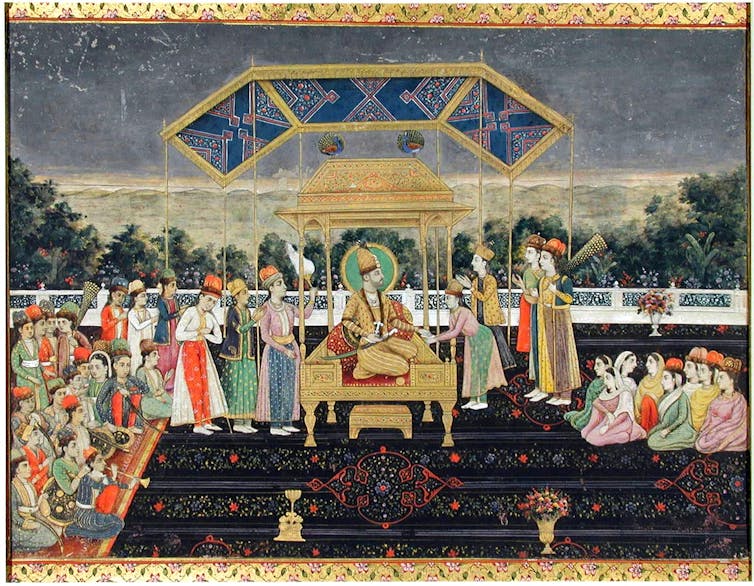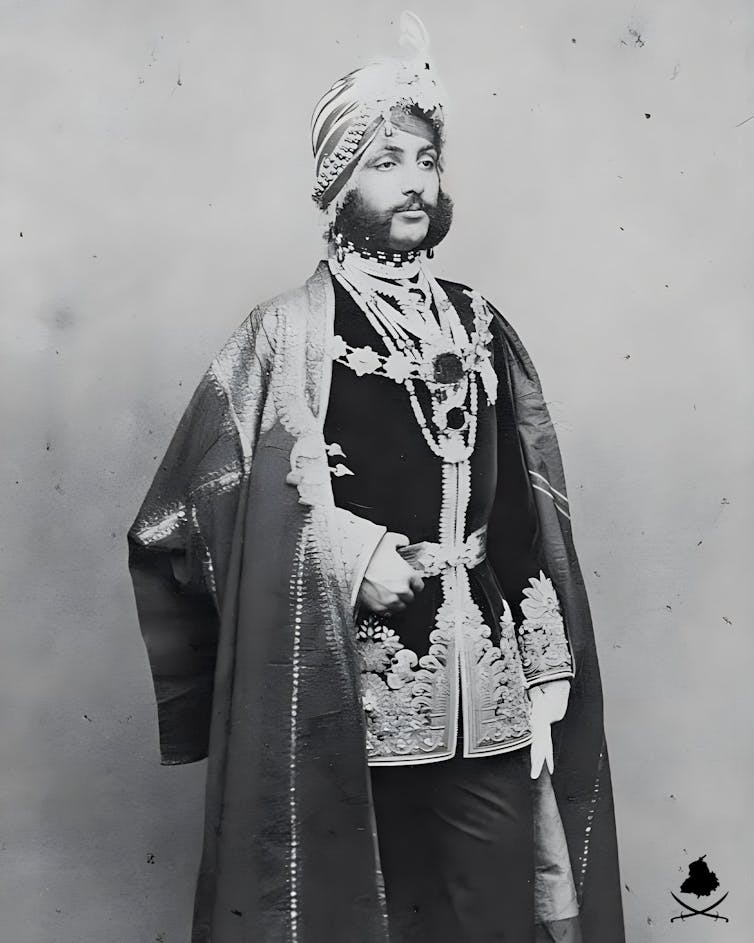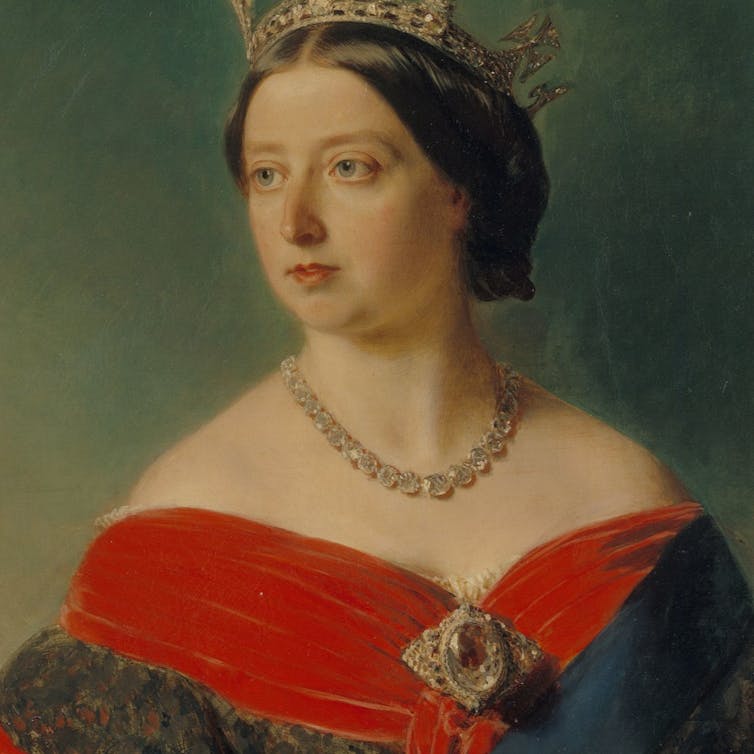Ahead of King Charles’s coronation on May 6 2023, Buckingham Palace has announced that Camilla, the Queen consort, will be wearing a modified version of the crown made for Queen Mary, the consort of George V. This is the first time since the 1700s that a queen consort crown is being reused. Even more notably, the Koh-i-Noor diamond will not be used in the crown.
This most precious item among the crown jewels of the United Kingdom is also the most controversial. A piece of colonial legacy, it has long been the subject of reparation demands by the Indian government.
Koh-i-Noor is no ordinary diamond. It has been symbolic of the rise, zenith and fall of mighty empires. Never sold or bought, it has instead been a gemstone of victors in India, Persia, Afghanistan, and, since the mid-19th century, in the UK.

How the British took the diamond
Quite where in India Koh-i-Noor (Persian for “mountain of light”) originated has been debated. Some have said it was mined in the Kollur Mine in Golconda, close to the Krishna river, in what is now Andhra Pradesh. Others have traced it to the lower bed of the Godavari river in the country’s centre.
The diamond is more accurately accounted for and its political relevance made clearer in medieval records of the Mughal rulers who possessed it for over a century until the Persian invasion of India in 1738-39. From the Persian ruler Nadir Shah, it then passed into the hands of the Afghan Durrani dynasty in 1749 and from them to the Sikhs in 1813.
By the late 18th century, the British East India Company had become a key political player in the Indian subcontinent. Its officials were aware of the glory of Koh-i-Noor because the founding ruler of the north-western Sikh kingdom, Maharaja Ranjit Singh, flaunted it as his realm’s most prized possession.
Following the death of Ranjit Singh, the Sikh kingdom began to collapse. During the second Anglo-Sikh war (1848-1849), British East India Company forces deposed the 10-year-old king, Maharaja Duleep Singh. They placed him under company-appointed British guardianship, then took over his territories and state properties, seizing all the treasury goods kept in the capital city, Lahore, as well as the Koh-i-Noor and Darya-i-Noor jewels. The British estimated the value of these seized goods – excluding Koh-i-Noor – to be at least 37,15,303 rupees (equivalent to roughly £745 million at current rates).
According to the treaty of submission which the company made Duleep Singh sign on March 29, 1849:
All the property of the State, of whatever description and wheresoever found, shall be confiscated to the Honorable East India Company, in part payment of the debt due by the State of Lahore to the British Government, and of the expenses of the war. The Gem called the Koh-i-noor, which was taken from Shah Shooja-ool-Moolk by Maharajah Runjeet Sing, shall be surrendered by the Maharajah of Lahore to the Queen of England.

A prize of conquest
In April 1849, Koh-i-Noor was handed over to the British crown by Lord Dalhousie, who from 1848 to 1856, was Governor-General of India, under the command of the British East India Company.
Dalhousie had singled out Koh-i-Noor as a “historical memorial of conquest”. But, unconventionally, he reserved it for the British monarch, Queen Victoria, and not for his company “court of directors”, as all other confiscated properties were.
The British East India Company was founded by royal charter in 1600 as a joint stock trading company and governed by a company court of directors from London. In 1784, the British government also began to oversee the company’s affairs in India via a board of control.
From the mid-18th century, the company had become a de facto state. Boasting an army and forts, it acquired territories. And it shared dual sovereignty from the British crown and from the Mughal empire. Both conferred to the company certain rights and laws: the rights to collect taxes, to protect its boundaries, to carry out diplomatic ties, to wage wars. Marking this shift from a trading company to a company state, it became known as company bahadur (which means, “the valiant, honourable company”) across South Asia.
When the company court of directors were not given the gem, they took offence. “The Court, you say,” wrote Dalhousie to his close friend, Sir George Couper, on August 16 1849, “are ruffled by my having caused the Maharajah to cede to the Queen the Koh-i-noor.”
The former chairman of the board of control, Lord Ellenborough, meanwhile, was indignant that Dalhousie had not given everything to the monarch. He wrote:
What business has this [Governor General] to confiscate anything to the Company? It belongs to the Queen, and the army have a right to demand it, and I tell you it is dangerous to refuse it.

Caught in the power tussle between the court of directors and the board of control, Dalhousie wrote that he felt like “a bundle of hay between two asses”. “Admitting to the utmost the abstract right of the Queen to all property in a conquered country,” he said, in his written defence against Ellenborough, “such has not been the practice in India”.
Dalhousie defended his bypassing of the court of directors’ authority, saying he had acted as much in their own interests as he had in the Crown’s:
It was more for the honour of the Queen that the Koh-i-Noor should be surrendered directly from the hand of the conquered prince into the hands of the sovereign who was his conqueror, than that it should be presented to her as a gift —- which is always a favour -— by a joint-stock company among her subjects.
On March 30 1849, he wrote to Couper from Punjab:
What I have done I have done on my own responsibility. I know it to be just, politic, and necessary. […] It is not every day that an officer of their Government adds four millions of subjects to the British Empire, and places the historical jewel of the Mogul Emperors in the Crown of his own Sovereign. This I have done. Do not think I unduly exult.
Dalhousie, as a loyal British subject of Her Majesty, went out of his way to secure Koh-i-Noor for the British crown, as a symbol of imperial glory. For Duleep Singh and the Sikh kingdom, it was a treasure that East India Company officials forced them to surrender upon defeat in 1849.
Arun Kumar ne travaille pas, ne conseille pas, ne possède pas de parts, ne reçoit pas de fonds d'une organisation qui pourrait tirer profit de cet article, et n'a déclaré aucune autre affiliation que son organisme de recherche.
This article was originally published on The Conversation. Read the original article.







